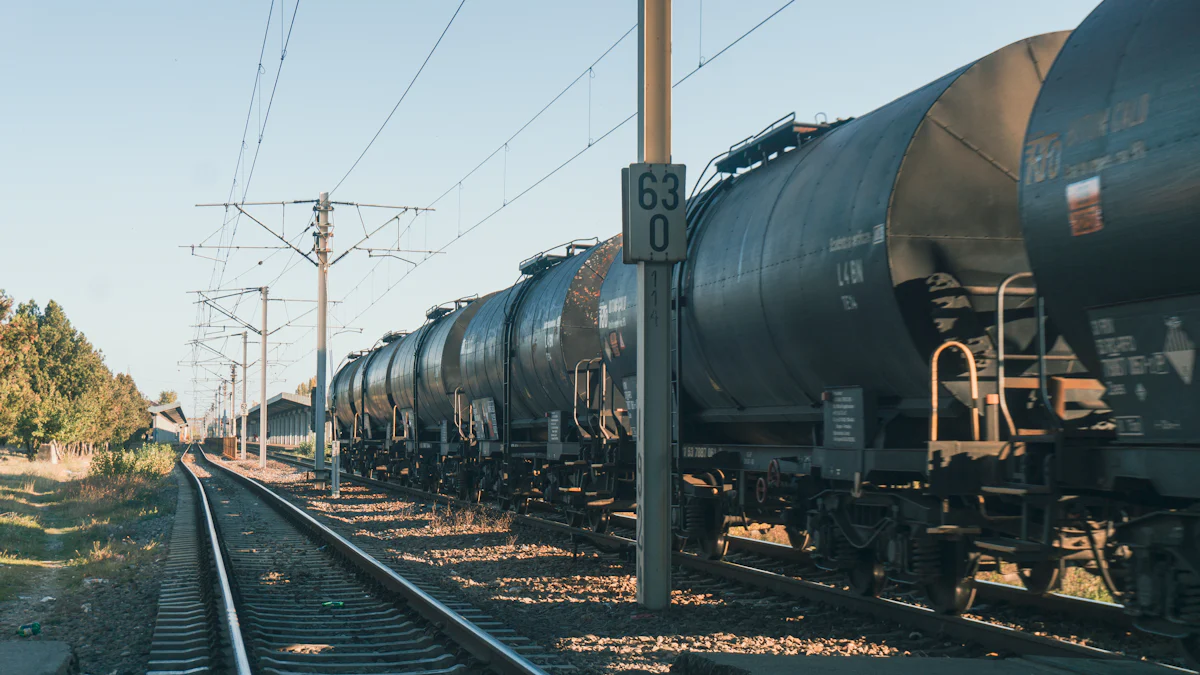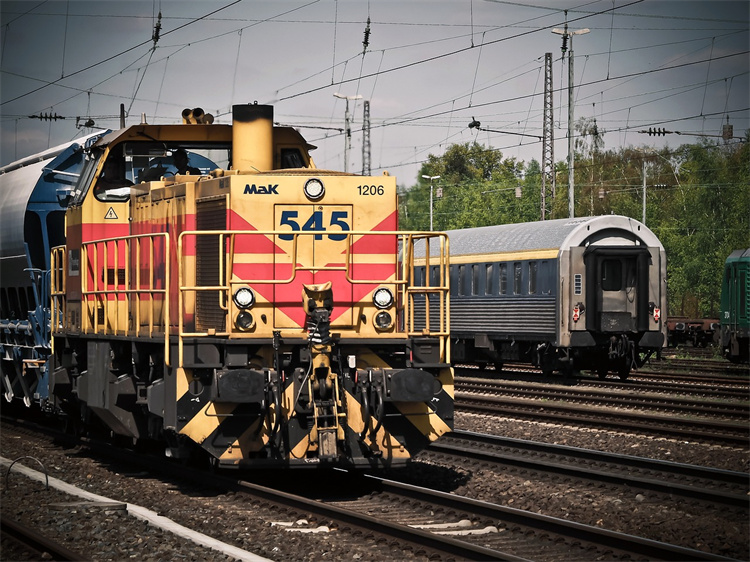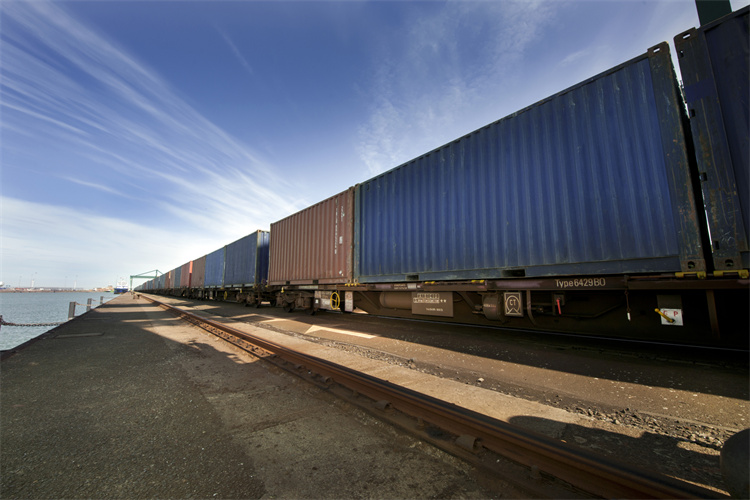Learn how the China Europe Railway saves time

The China-Europe Railway has transformed freight transportation between China and Europe by drastically cutting transit times. While traditional sea freight can take up to 45 days, the railway completes the journey in just 12 to 16 days, offering a much faster solution for businesses. This efficient alternative ensures timely delivery of goods, making it a top choice for international trade. Moreover, the China-Europe Railway provides dependable schedules and reduces delays, ensuring consistency in global logistics. Enhanced customs procedures further boost efficiency, enabling goods to cross borders smoothly. By connecting China and Europe with speed and reliability, the China-Europe Railway serves as a strong competitor to both air and sea freight options.
Key Takeaways
The China-Europe Railway drastically reduces transit times, completing journeys in just 12 to 16 days compared to traditional sea freight, which can take up to 45 days. This railway offers a cost-effective alternative, balancing speed and affordability, making it an ideal choice for businesses with time-sensitive shipments.
Streamlined customs and border processes enhance efficiency, allowing goods to cross borders smoothly and reducing delays.
With over 92 operational routes connecting 35 cities in China to 34 cities in Europe, the railway provides extensive coverage for international logistics. The railway's environmental benefits include a 30% reduction in carbon emissions compared to air freight, supporting sustainable transportation practices.
Reliable schedules and high-frequency service ensure businesses can plan shipments effectively, maintaining efficient supply chains.
As a key component of the Belt and Road Initiative, the China-Europe Railway fosters economic cooperation and strengthens global trade networks.
Overview of the China-Europe Railway Express

What is the China-Europe Railway Express?
The China-Europe Railway Express serves as a vital link between China and Europe, offering a faster and more reliable alternative to traditional shipping methods. Launched in 2013, this extensive rail network connects numerous cities across the two continents, facilitating the movement of goods through land-based transportation. Unlike maritime shipping, which can take up to 45 days, the railway completes the journey in just 12 to 16 days. This time-saving advantage has made it a preferred choice for businesses seeking efficient logistics solutions.
The China-Europe Railway Express operates as part of China's Belt and Road Initiative, which aims to enhance connectivity and trade between Asia, Europe, and beyond. By providing multimodal container rail services, it supports the seamless integration of rail, sea, road, and air transportation. This innovative approach has revolutionized freight logistics, enabling businesses to transport goods such as electronics, machinery, and consumer products with greater speed and security.
Key routes and destinations of the China-Europe Railway
The China-Europe Railway spans a vast network of routes, connecting approximately 35 cities in China with 34 cities in Europe. Key routes include the Chongqing-Duisburg line, which covers over 11,000 kilometers, and the Yiwu-Madrid route, known for its extensive reach. These routes serve as critical arteries for trade, linking major industrial hubs in China to prominent economic centers in Europe.
The railway's network has expanded significantly since its inception. It now includes 92 operational routes, connecting over 200 towns across 24 European nations. This extensive coverage ensures that businesses can access a wide range of destinations, making the railway a versatile option for international logistics. The key routes not only facilitate trade between China and Europe but also promote economic development in regions along the way.
The role of the China-Europe Railway in global trade
The China-Europe Railway Express plays a pivotal role in strengthening global trade by providing a reliable and cost-effective transportation solution. Its ability to reduce transit times has made it an attractive option for businesses looking to streamline their supply chains. By offering a middle ground between the speed of air freight and the affordability of sea freight, the railway has become a cornerstone of international logistics.
This rail network has transported over 50,000 types of goods, ranging from automobiles to consumer electronics. Its environmental benefits further enhance its appeal, as it reduces carbon emissions by approximately 30% compared to air freight. The China-Europe Railway also contributes to stabilizing global supply chains, especially during periods of disruption in traditional shipping routes. By bridging the gap between China and Europe, it fosters economic cooperation and accelerates the cross-border flow of resources.
How the China-Europe Railway Saves Time

Comparison of transit times: China-Europe Railway vs. sea and air freight
In contrast, the China-Europe Railway completes the same route in just 12 to 16 days.
Air freight provides faster delivery than sea freight, often completing shipments within 5 to 7 days. However, the high costs associated with air freight make it less accessible for many businesses. The China-Europe Railway Express bridges this gap by offering a middle ground—faster than sea freight and more affordable than air freight. This balance of speed and cost positions the railway as a competitive option for international logistics.
The rail network also ensures consistent transit times, unlike sea freight, which is often affected by weather conditions and port congestion. By maintaining predictable schedules, the China-Europe Railway enhances the efficiency of supply chains and supports the growth of global trade.
Streamlined customs and border processes on the China-Europe Railway Express
Efficient customs and border processes play a crucial role in reducing delays along the China-Europe Railway Express. The railway benefits from streamlined procedures that simplify the movement of goods across multiple countries. Collaborative agreements between China, Europe, and other participating nations have established standardized documentation and inspection protocols. These measures minimize the time spent at border crossings.
The China-Europe Railway also utilizes advanced technology to further enhance efficiency. Automated systems for cargo tracking and customs clearance reduce manual intervention, speeding up the entire process. For instance, goods transported via the railway often undergo pre-clearance procedures, allowing them to move seamlessly through checkpoints. This level of coordination ensures that shipments reach their destinations without unnecessary delays.
By prioritizing safety and reliability, the railway has built trust among businesses. The smooth handling of customs formalities contributes to its growing popularity as a preferred mode of transportation for global trade.
Frequency and reliability of the China-Europe Railway service
The China-Europe Railway Express operates with high frequency, offering regular departures along its extensive network of routes. With over 92 operational routes connecting 35 cities in China to 34 cities in Europe, the railway provides businesses with multiple scheduling options. This frequent service ensures that companies can plan shipments according to their specific needs.
Reliability remains a key strength of the China-Europe Railway. Unlike sea freight, which often faces delays due to port congestion or adverse weather, the railway adheres to fixed schedules. This consistency allows businesses to maintain efficient supply chains and meet delivery deadlines. The China-Europe Railway Express has also demonstrated resilience during disruptions in traditional shipping routes, further solidifying its reputation for dependability.
The railway's infrastructure supports its operational efficiency. Advanced tracking systems provide real-time updates on shipment status, enhancing transparency and enabling businesses to monitor their goods throughout the journey. This combination of frequent service and reliable performance underscores the economic impact of the China-Europe Railway on international logistics.
Logistics and Operational Details of the China-Europe Railway Express
Types of goods transported on the China-Europe Railway
The China-Europe Railway has become a vital channel for transporting a wide variety of goods. This rail network handles over 50,000 types of products, including machinery, electronics, automobiles, and consumer goods. Businesses rely on this service to move high-value items like laptops, smartphones, and industrial equipment. The railway also supports the shipment of bulk materials, such as raw metals and chemicals, which benefit from its strong transportation capacity.
The versatility of the China-Europe Railway Express makes it an attractive option for industries across sectors. Companies in the automotive industry use it to ship vehicles and spare parts, while retailers depend on it for fast delivery of seasonal merchandise. The ability to transport both high-value and bulk goods highlights the adaptability of this rail network. By offering a reliable and cost-effective solution, the railway has become a cornerstone of global trade between China and Europe.
Infrastructure and technology supporting the China-Europe Railway Express
The infrastructure of the China-Europe Railway Express plays a critical role in its efficiency and reliability. Modern container terminals equipped with advanced handling systems ensure smooth loading and unloading processes. These facilities optimize operations, reducing delays and enhancing throughput capacity. The railway spans approximately 11,000 kilometers, connecting major cities in China and Europe through well-maintained tracks and stations.
Technology further strengthens the operational capabilities of the railway. Automated cargo tracking systems provide real-time updates, allowing businesses to monitor shipments throughout the journey. Train traffic management systems improve scheduling and minimize disruptions along the routes. Pre-clearance procedures at customs checkpoints streamline border crossings, ensuring faster transit times. These technological advancements enhance the safety and reliability of the service, making it a preferred choice for international shipping.
The environmental benefits of the railway's infrastructure also deserve attention. By shifting freight from maritime and air transport to rail, the network reduces carbon emissions by approximately 30%. This eco-friendly approach aligns with global efforts to promote sustainable transportation solutions.
Coordination between China, Europe, and other operators
The success of the China-Europe Railway Express depends on seamless coordination between China, Europe, and other participating operators. Collaborative agreements between countries have established standardized procedures for customs clearance and documentation. These agreements simplify the movement of goods across borders, reducing delays and ensuring efficient operations.
Operators in China and Europe work closely to maintain the frequency and reliability of the service. Scheduled departures and fixed transit durations allow businesses to plan shipments with confidence. Freight forwarding companies play a key role in managing logistics, ensuring that goods reach their destinations on time. The railway's ability to adapt to changing market demands demonstrates its agility and resilience.
The cooperation between nations also extends to infrastructure development. Investments in rail terminals, technology, and maintenance ensure the long-term sustainability of the network. This collaborative approach enhances the economic impact of the railway, fostering stronger trade ties between China and Europe. By prioritizing coordination and innovation, the China-Europe Railway continues to set new standards in international freight transportation.
Benefits Beyond Time Savings of the China-Europe Railway
Cost-effectiveness of the China-Europe Railway Express
The China-Europe Railway Express offers a cost-effective solution for businesses seeking efficient transportation between China and Europe.
The affordability of the China-Europe Railway Express also stems from its ability to balance speed and cost. While air freight provides faster delivery, its high expenses often deter businesses. Rail freight bridges this gap by offering a middle-ground solution—faster than sea freight yet more economical than air freight. This balance ensures that companies can optimize their supply chains without incurring excessive costs. The railway's extensive network of routes further enhances its value, connecting key cities in China and Europe while maintaining competitive pricing.
Environmental advantages of the China-Europe Railway
The China-Europe Railway stands out as an environmentally friendly alternative to traditional shipping methods. Rail freight produces significantly lower carbon emissions compared to air and sea transport. For example, the railway reduces carbon emissions by approximately 30% compared to air freight. This reduction aligns with Europe's push for sustainable transportation solutions, making the railway a preferred choice for eco-conscious businesses.
Trains consume less energy per mile traveled than airplanes and do not emit fossil fuel emissions like cars and trucks. This energy efficiency contributes to the railway's lower environmental footprint. By shifting freight from maritime and air transport to rail, the China-Europe Railway Express supports global efforts to combat climate change. Its eco-friendly approach not only benefits the environment but also enhances its appeal to companies prioritizing sustainability in their operations.
Stabilizing global supply chains through the China-Europe Railway
The China-Europe Railway plays a crucial role in stabilizing global supply chains.
The railway's extensive network of routes connects over 200 towns across Europe and China, ensuring seamless integration into international logistics. This connectivity fosters economic cooperation and accelerates the movement of resources. By providing a dependable transportation solution, the China-Europe Railway Express strengthens its impact on global trade. Its ability to adapt to changing market demands further solidifies its position as a cornerstone of international freight transportation.
The China-Europe Railway and the Belt and Road Initiative
How the China-Europe Railway supports the Belt and Road Initiative
The China-Europe Railway Express plays a pivotal role in advancing the goals of the Belt and Road Initiative. This initiative, launched by China, aims to enhance global trade and connectivity by creating modern infrastructure and transportation networks. The railway serves as a critical component of this vision, offering a reliable overland route that complements traditional maritime shipping lanes.
Since its inception, the China-Europe Railway Express has provided an efficient alternative for transporting goods between China and Europe. By reducing transit times and costs, it has strengthened trade ties and facilitated economic cooperation. The railway’s ability to connect major industrial hubs in China with key cities in Europe has made it an essential part of the Belt and Road Initiative’s strategy to promote open trade and integration.
The railway also supports the initiative’s environmental goals. By shifting freight from air and sea transport to rail, it reduces carbon emissions and energy consumption. This eco-friendly approach aligns with the initiative’s commitment to sustainable development, making the railway a model for green logistics.
“The China-Europe Railway Express is not just a transportation network; it is a bridge of cooperation and a path to shared prosperity.” – A statement reflecting its strategic importance.
Expanding connectivity between China and Europe
The China-Europe Railway has significantly expanded connectivity between China and Europe, creating a vast network that spans almost the entire Eurasian continent. This network connects 35 cities in China with 34 cities in Europe, linking over 200 towns across 24 European nations. Such extensive coverage has transformed the railway into a vital artery for intercontinental trade.
Key routes, such as the Chongqing-Duisburg line and the Yiwu-Madrid route, have become essential for businesses seeking efficient logistics solutions. These routes facilitate the movement of goods ranging from electronics to raw materials, ensuring that industries across sectors benefit from improved connectivity. The railway’s ability to integrate seamlessly with other modes of transportation, including road and sea, further enhances its role in global trade.
The expansion of the railway network has also fostered economic growth in regions along its routes. By connecting remote areas to major trade hubs, the railway has opened new markets and created opportunities for local businesses. This network expansion continues to strengthen the economic partnership between China and Europe, driving mutual growth and development.
Future developments in the China-Europe Railway network
The future of the China-Europe Railway network holds immense potential for further growth and innovation. Plans for network expansion aim to increase the number of operational routes and improve the efficiency of existing ones. These developments will enhance the railway’s capacity to handle growing trade volumes and meet the demands of global supply chains.
Technological advancements will play a crucial role in shaping the railway’s future. Investments in automated systems, real-time tracking, and smart logistics solutions will improve operational efficiency and reduce transit times. These innovations will ensure that the railway remains competitive in an evolving global trade landscape.
The railway’s role in the Belt and Road Initiative will continue to evolve, with a focus on fostering deeper economic integration between China and Europe. Future projects may include the development of new trade corridors and the establishment of additional logistics hubs. These initiatives will strengthen the railway’s position as a cornerstone of international freight transportation.
By prioritizing sustainability, the railway will also contribute to global efforts to combat climate change. Its commitment to reducing carbon emissions and promoting green logistics will make it a leader in environmentally friendly transportation solutions.
The China-Europe Railway Express has revolutionized international logistics by offering faster transit times, dependable schedules, and efficient customs processes. Its ability to reduce delivery times has made it a preferred choice for businesses managing global supply chains. Beyond time savings, the railway provides cost-effective and eco-friendly solutions, reducing carbon emissions and supporting sustainable trade practices. By connecting key cities in China and Europe, it enhances economic cooperation and strengthens global trade networks. As a cornerstone of the Belt and Road Initiative, the China-Europe Railway Express continues to evolve, promising greater efficiency and connectivity in the future.
See Also
Affordable Transportation Management: Your Budget's New Ally
Unlocking Logistics Savings: Expert Tips for Supply Chain Success
Stop Overpaying: Effective Strategies to Cut Supply Chain Costs
Get Prepared: Discovering Cutting-Edge Transport Tech for Supply Chains
Is Your Business Prepared for Transport Technology Innovations?
